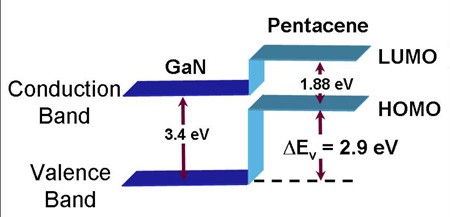 Organic semiconductor materials have shown promise in recent years for use in low-cost electronics applications such as photovoltaics, chemical sensors, and flat-panel displays. In particular, pentacene thin films have been shown to exhibit high a large field-effect mobility on the order of 1 cm2/Vs, which is sufficient for organic thin-film transistors (TFTs) for displays. However, the performance of organic electronic devices can often be limited by charge injection from the contact materials. A large contact resistance causes energy to be lost in the device which could make it impractical to operate. In addition, much of that energy would likely be lost in the form of heat which could degrade the organic material an limit device lifetimes. Gallium Nitride has several favorable properties which make it particularly promising for use as a charge injection contact for organic materials. GaN is attractive is due to the ability to achieve appreciable p-type doping and in turn, mobile hole concentrations of ~1àƒ—1018 cm 3 in the bulk for use in charge injection. Gallium Nitride is also largely chemically inert, due in part to its relatively high ionic character serving to limit interfacial interactions with organic materials and also allow for GaN to be used in harsh environments such as in aqueous solution. The ionic character of GaN also serves to push its surface states out to near the band edges where they have less of an impact on the formation of an electrical contact. Our work has focused on the nature of the GaN-pentacene interface under surface preparation conditions normally encountered in GaN processing. Our X-ray photoemission spectroscopy measurements indicate that there was no interfacial chemical reaction between the HCl-cleaned GaN and pentacene, while the ultraviolet photoemission spectroscopy measurements found a unique band-offset favorable for hole-injection from the GaN layer into pentacene. This band alignment is appropriate for ohmic hole-injection from GaN into organic materials of high ionization potential opening up a new class of heterojunctions for optical and electronic devices.
Organic semiconductor materials have shown promise in recent years for use in low-cost electronics applications such as photovoltaics, chemical sensors, and flat-panel displays. In particular, pentacene thin films have been shown to exhibit high a large field-effect mobility on the order of 1 cm2/Vs, which is sufficient for organic thin-film transistors (TFTs) for displays. However, the performance of organic electronic devices can often be limited by charge injection from the contact materials. A large contact resistance causes energy to be lost in the device which could make it impractical to operate. In addition, much of that energy would likely be lost in the form of heat which could degrade the organic material an limit device lifetimes. Gallium Nitride has several favorable properties which make it particularly promising for use as a charge injection contact for organic materials. GaN is attractive is due to the ability to achieve appreciable p-type doping and in turn, mobile hole concentrations of ~1àƒ—1018 cm 3 in the bulk for use in charge injection. Gallium Nitride is also largely chemically inert, due in part to its relatively high ionic character serving to limit interfacial interactions with organic materials and also allow for GaN to be used in harsh environments such as in aqueous solution. The ionic character of GaN also serves to push its surface states out to near the band edges where they have less of an impact on the formation of an electrical contact. Our work has focused on the nature of the GaN-pentacene interface under surface preparation conditions normally encountered in GaN processing. Our X-ray photoemission spectroscopy measurements indicate that there was no interfacial chemical reaction between the HCl-cleaned GaN and pentacene, while the ultraviolet photoemission spectroscopy measurements found a unique band-offset favorable for hole-injection from the GaN layer into pentacene. This band alignment is appropriate for ohmic hole-injection from GaN into organic materials of high ionization potential opening up a new class of heterojunctions for optical and electronic devices.